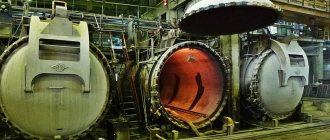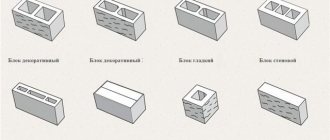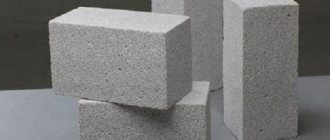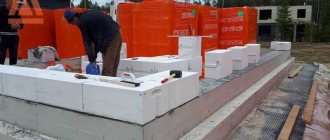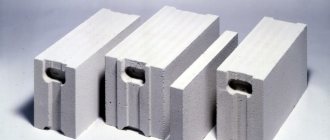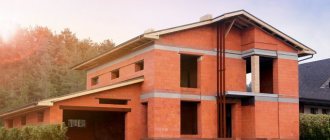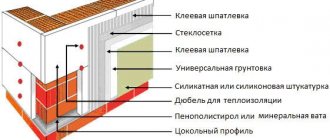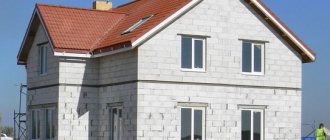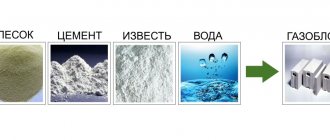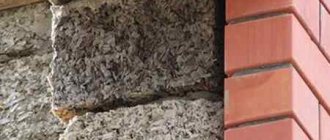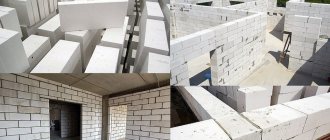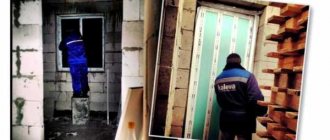Aerated concrete and expanded clay concrete belong to the class of cellular concrete. The structure of this class of materials implies the presence of cavities with air. They make up the majority of the product volume.
Manufacturing using this technology not only leads to a reduction in costs by saving raw materials. But it also allows you to reduce the weight of products. Their thermal insulation properties also improve.
Differences in how materials are produced
For the production of aerated concrete the following is used:
- Cement;
- Sand;
- Water;
- Aluminum powder necessary for gas formation;
- Lime;
- Other additives.
Its industrial production is widespread, but the technology is simple enough to be mastered by small companies or individual production when building their own housing.
Blocks created at a large factory using expensive equipment will differ fundamentally in characteristics from handicraft products.
Typically, this concrete is poured into large molds and then cut into smaller pieces. In single, small-scale production, concrete is poured into molds, then sawing is not used.
The manufacturing technology of expanded clay concrete is simpler. It is great for small-scale production, creating your own foundation or blocks when building a private house. Production consists of two main stages: mixing components and molding.
Raw materials used for production:
- Cement;
- Sand;
- Water;
- Expanded clay.
Expanded clay is a porous substance obtained in a special way from clay or other raw materials containing it, for example, clay shales. Expanded clay contains cavities with air, which reduces the weight of the final product and increases thermal insulation properties. It plays the role of a filler, the binding element is cement.
Arbolite blocks
Specifications
Arbolite block.
“Wooden blocks” are used in construction in any climatic zone of the country due to their exceptional properties:
- State standard. Wood concrete was first learned about during the Soviet Union, and standards were approved in 1983. According to the standards, the material does not require additional insulation, since upon release a finishing layer is prepared that retains moisture. There are two types of wood concrete based on thermal insulation characteristics: structural, used in the construction of external walls; thermal insulation, used for internal partitions.
- Weight. Lightweight building material does not require the installation of a reinforced foundation.
- Size. According to the parameters, four groups are distinguished: wide (500*250*300 mm); medium (500*250*200 mm); narrow (500*250*150 mm); connecting (1500*250*300 mm).
- Thermal conductivity. High heat capacity is an excellent property of wood concrete. The temperature inside a room made of such material is always comfortable. The substance easily absorbs heat and moisture and releases them easily.
- Strength. There is no definitive answer to the durability of the material. Treating the walls with a primer and covering them with natural stone will help extend the service life. The material is characterized by elasticity and cracks do not appear on it. Recently, the addition of latex to the composition further increases strength.
- Environmentally friendly. Builders have differing opinions on the issue of harmfulness, but experts say that the durable material is ideal for those who care about their health. It becomes harmful only if the manufacturing technology is violated.
- Frost resistance. The blocks can withstand low temperatures and can withstand freezing and defrosting, but in the absence of moisture.
- Fire safety. Although the composition includes wood elements, the material does not support combustion. There is no need to use special fireproof protection.
Return to contentReturn to content
Advantages
Characteristics of wood concrete.
For comparison, we highlight a number of advantages:
- pressure resistance, alignment to the original shape;
- low thermal conductivity;
- does not require additional reinforcement or frame;
- in conditions of high humidity, excess is absorbed and removed, natural air circulation occurs;
- does not shrink.
Return to contents
Flaws
Negative properties include:
- cellulose contained in the composition and the need for constant protection from moisture. If the material succumbs to moisture, swells, and may begin to deteriorate;
- loose filler is not suitable for creating a perfect configuration, so in work you constantly need to use a plumb line and adjust the resulting curvatures;
- The cost of the product is high, you won’t be able to save money.
Return to contents
Distinctive qualities of gas and expanded clay concrete
The filler determines the higher strength characteristics of expanded clay concrete (up to 150 kg/cm2), so it can be used for the construction of multi-story buildings. Aerated concrete can withstand loads of only 35 to 65 kg/cm2. This disadvantage is compensated by the low weight of aerated concrete blocks. However, it is not recommended to make walls more than 15 meters high from them. This difference is due to the structure and composition of concrete.
The surface structure determines the performance properties. Laying concrete blocks with expanded clay as a filler requires a thick layer of cement-sand mixture - up to 1.5 cm. When installing aerated concrete blocks, it is enough to apply 0.2 cm of special glue.
The thickness of the seam affects the thermal insulation; in fact, walls made of less heat-permeable expanded clay concrete are less heat-resistant due to cold bridges created by the seams.
Finishing the room, in this case, will not take much time and will require less labor due to the high smoothness of the building elements. Expanded clay concrete needs to be carefully plastered, leveling its surface.
Disadvantages of wood concrete
The disadvantages of wood concrete include:
- blocks with cellulose must be protected from moisture, otherwise, if they are constantly wet, they will swell and begin to decompose;
- Due to the loose filler, wood concrete blocks cannot be given a perfectly even shape. That is why, when laying blocks, you should control each row for plumb and level and correct all possible distortions;
- price. It is quite large, so other porous compositions are often chosen during construction.
Which building material is more expensive?
When comparing expanded clay concrete and aerated concrete blocks, if we count them by cubic meters, then average quality products come out cheaper. But there are a number of nuances that cast doubt on this conclusion. When calculating the costs of constructing a building, its use may turn out to be more profitable.
This is due to the following properties of aerated concrete:
Firstly, the installation of a reinforced belt over the walls is a prerequisite for the use of this concrete. But for expanded clay concrete such complication of the design is rarely required.
Secondly, laying in one layer for this concrete is the exception rather than the rule. It is less dense, more fragile. It is recommended to make the walls of the house, especially load-bearing ones, thicker than 20 cm. Only then are they guaranteed to withstand the load.
Thirdly, gas-filled concrete made from high grades of cement is comparable in strength to expanded clay concrete, but is much more expensive.
To answer the question “should I choose aerated concrete or expanded clay concrete?”, we compare all the properties that can affect the cost of building materials and the living conditions in the future home.
Price
If we compare materials by cost, then wood concrete, which belongs to the new generation of materials, costs much more. Those who build a one-story building, or those who live in warm regions where the walls of the house are erected in one row, usually do not worry about the issue of price.
And yet, despite the high cost of wood concrete, it is increasingly used in building construction, and buyers choose aerated concrete less and less often. At the same time, one should not think that wood concrete has never been known to builders. It was widely used in mass construction during the Soviet period, however, for some time they forgot about the material, giving preference to concrete blocks.
What to consider when choosing a material
The choice is influenced by performance properties. The issue of thermal insulation is acute for both materials. If concrete blocks with expanded clay as a filler are one of the best heat insulators, then the technology for laying it worsens this quality.
Walls made of this concrete show slightly better thermal protection characteristics, which can hardly be called a significant advantage. Therefore, buildings made of aerated concrete and expanded clay concrete require additional thermal insulation.
We must remember that it is less durable and easy to process. This quality will come in handy when building a house. But when using it, you need to be prepared to give up decorating the interior with heavy objects. Walls that crumble under load may not support carpets or paintings hung on them.
Expanded clay concrete is often used to make a monolithic foundation. Aerated concrete can be used for the same purpose. To achieve acceptable strength parameters, it needs to be reinforced.
Comparison of wood concrete and aerated concrete
To compare materials according to their technical and economic indicators, two similar structural blocks corresponding to strength class B2.5 were taken. Below are only comparative characteristics that significantly affect the quality and cost of the structure being built.
| Physical, technical and economic characteristics | Aerated concrete | Arbolit | Expert commentary |
| Average cost of materials, rub./m³ | 3000…3500 | 4200…5000 | This difference will lead to an overall increase in the cost of building an average cottage with an area of about 100 m² by approximately 25,000 rubles. compared to gas blocks. |
| Thermal conductivity, W/m °C | 0,11…0,12 | 0,12…0,15 | The heat conductivity of wood concrete blocks is greater, therefore, energy losses in such a house in winter will be greater than when using aerated concrete. |
| Frost resistance | F50…F100 | F25 | Advertising information is replete with the high frost resistance of wood concrete, but an analysis of the regulatory documentation reveals its fragility in comparison with aerated concrete walls. |
| Moisture resistance, (water absorption coefficient) | less than 15% | reaches 85% | Wood concrete is 90% wood, which actively absorbs moisture. A structure made of wood concrete blocks requires serious waterproofing of the walls. In addition, this leads to complication of the masonry process. All these features entail an increase in the cost of the estimate. |
| Weight, kg/m³ | 400 | 680 | The heavier the walls, the higher the load on the soil foundation. This is important for unstable soils where the use of piles will be required. |
| Block size accuracy, mm | 1 | 5 | Even a 5 mm deviation in size between wood concrete blocks will require additional work to level the walls. Similar operations when using aerated concrete are reduced to light puttying. The precision of the geometry of aerated concrete blocks minimizes seams and eliminates “cold bridges” in aerated concrete walls. |
Pros and cons of aerated concrete
Main advantages:
- Low density results in low weight for the same volume. Weight is three times less than that of bricks;
- Using special glue instead of cement during installation;
- Thin seams at the joints;
- Not complicated processing - excellent grinding and cutting;
- The smooth, even surface of factory-made products allows you to reduce labor costs for interior finishing.
Construction from aerated concrete.
Flaws:
- Relatively high fragility due to the presence of pores;
- Formation of cracks during shrinkage;
- High moisture permeability requires the installation of additional waterproofing;
- Requires the use of special fasteners;
- Buildings are often damaged by rodents, who easily make passages in the relatively soft substance.
Peculiarities:
- High vapor permeability prevents condensation from accumulating in the room, making the room drier. If installed outside, additional insulation will be required.
- It is not recommended to make load-bearing structures. Due to increased fragility, consumption increases and the profitability of construction decreases.
- Excellent for installing internal partitions that do not bear any load.
Advantages of aerated concrete
The main advantages of aerated concrete are as follows:
- lightness of the material. Blocks of impressive size of 1 cubic meter weigh much less than the same volume of ordinary brick;
- builders prefer to work with aerated concrete because it is easy to process: sawing, drilling, grinding;
- the geometry of aerated concrete is its positive feature, which makes it easy and convenient to lay blocks;
- environmental passports are issued for aerated concrete, which confirm the possibility of its use in housing construction, since it is environmentally friendly;
- some manufacturers produce aerated concrete in precise sizes, which allows it to be folded like a construction set, and the special texture and color help save on any finishing of the building - internal and external;
- high-quality aerated concrete has high frost resistance and can easily withstand hundreds of cycles of freezing and subsequent thawing, so that if the technological process is followed, the concrete box will last for at least a hundred years.
Advantages and disadvantages of expanded clay blocks
Main advantages:
- High strength;
- Low cost, almost one and a half times cheaper than construction using bricks;
- Easy to do yourself, as no complex equipment is required;
- Holds standard fasteners well;
- Durable, not prone to cracking;
- High biological resistance. Not prone to mold and mildew formation;
- Low vapor permeability;
- Non-flammable;
- Excellent sound insulation;
Flaws:
- The surface is rough, leveling requires additional effort during finishing work;
- A special tool is required for sawing;
- Wide cement joints increase the thermal conductivity of the walls;
- Does not withstand shock loads well.
Peculiarities:
- Excellent for laying any walls: both partitions and load-bearing.
- Low moisture permeability reduces the requirements for waterproofing when creating external walls of a building.
- Resistant to temperature changes.
Advantages of wood concrete
Arbolite has characteristics similar to aerated concrete, but is lighter because it is filled with wood chips. This technology makes it possible to improve the strength of the blocks and increase the thermal insulation characteristics.
Until now, builders are arguing which is better - wood concrete or aerated concrete. Typically, builders are guided by construction conditions and initial data, which are included in objective technical characteristics.
Arbolite, unlike aerated concrete, is more resistant to pressure, so it does not crack under heavy loads. This happens due to the fact that the filler inside the block is compressed. Other benefits include:
- a density of 800 kilograms per cubic meter gives the wood concrete low thermal conductivity, allowing the thermal insulation of the building to increase by 75 percent;
- buildings erected from this material do not need to be additionally reinforced or to build a reinforcing frame from a monolith;
- in conditions of high humidity, the wood filler of wood concrete absorbs excess moisture and then removes it from the building, due to which air circulates naturally in a closed room. In a house made of aerated concrete it is impossible to do without forced air ventilation;
- The environmental characteristics of a building made of wood concrete are significantly superior to those of buildings made of aerated concrete. The wood concrete block is only about forty centimeters thick, however, it is frost-resistant, maintains a comfortable atmosphere all year round and retains heat;
- construction of a building from such blocks is less expensive, since it is not necessary to invest additional resources in the construction of a monolithic strip foundation. The choice of the size of the future building is also not important - it is enough to pour a lightweight foundation, on which walls from wood concrete blocks will be erected;
- the building does not require additional insulation and does not shrink;
- wall finishing can be done immediately upon completion of construction, which reduces work time;
- Wood concrete, although it contains sawdust, will never rot and will not be affected by insects. It is convenient to work with it: chop, saw, drill. There is no need to rent special equipment for work;
- Unlike aerated concrete, wood concrete is attached to the walls with self-tapping screws, dowels or simple nails.
Comparison of properties and assessment of technical characteristics of blocks
Although it seems easier to make products from expanded clay concrete than from aerated concrete. But each of them has its own undeniable advantages, which determine their use.
When choosing a material, it is necessary to be guided by accurate data on technical characteristics. This will allow you to make a responsible and intelligent choice.
Building a house is a responsible undertaking during which rough estimates are unacceptable.
Table 1. Comparative technical characteristics
| Characteristic name | Aerated concrete | Expanded clay concrete |
| Strength class for concrete | B2.5 – B5 | B5–B1 |
| Thermal conductivity, W/(m°C) | 0,07 – 0,14 | 0,15 – 0,45 |
| Frost resistance, number of cycles | 100 | 200 |
| Weight 1 m3, kg | 300 – 600 | 850 – 1000 |
| Vapor permeability, mg/(m×h×Pa) | 20-23 | 0,3-0,9 |
Only by carefully studying the characteristics can you determine whether aerated concrete or concrete with expanded clay as a filler is best suited for construction.
We compare tolerances for the size and weight of building materials
The technology for manufacturing blocks from gas-filled concrete involves automatic cutting to predetermined parameters.
The autoclave production method uses large, sealed tanks. The blocks placed in them harden under special conditions that ensure no shrinkage. The surface is smoother, dimensional deviations do not exceed 0.5-1 mm. In non-autoclave production, when blocks are molded and solidified at normal pressure and temperature, the accuracy of the geometry is lower, the error reaches 2-3 mm.
Expanded clay blocks have an uneven surface, and deviations in geometric dimensions can reach 5-6 mm.
A comparison of expanded clay concrete and aerated concrete blocks by weight shows that the mass of the latter is significantly less. Depending on the production method and the shape of the product, it may differ three times.
Which of the 2 blocks retains heat better?
Expanded clay is an excellent thermal insulator, however, due to inaccuracy in size and shape, the blocks are laid with a wide cement joint. This leads to a significant increase in thermal conductivity.
Walls made of aerated concrete have lower thermal conductivity both due to the components of the product itself and due to the laying technology.
Frost resistance and fire resistance
Frost resistance is easy to determine by marking. The parameter is designated by the letter F. The numbers following the designation determine the number of freezing cycles that a given building material can withstand. The performance of aerated concrete is within 50-100 cycles. The frost resistance of concrete based on expanded clay reaches 200 cycles.
Both concretes belong to the non-combustible class. Integrity is maintained for several hours even under the influence of open fire.
Comparing shrinkage
After construction, buildings shrink during the first years. The consequences of this phenomenon will depend on the correct construction of the foundation and the correct distribution of loads. An illiterate approach to design or neglect of building codes can lead to serious damage to the structure and cracks in the walls.
The blocks themselves made of expanded clay concrete and aerated concrete undergo shrinkage in the first year: 0.3 – 0.4 mm/m. Such small deformations cannot seriously affect the integrity of the building or significantly deteriorate the condition of the load-bearing structures.
Environmental friendliness of building materials
Aerated concrete is an environmentally friendly material that is harmless to humans and does not contain toxic substances. The concentration of aluminum used in production is very small and does not affect human health.
Sometimes incorrect information appears about expanded clay, attributing negative properties to it. But it is made by firing from ordinary clay subjected to swelling. This is a natural material. It is not radioactive, toxic, and does not emit harmful gases. Absolutely safe for humans and recommended for furnishing residential premises.
Machinability of products and installation of fasteners
Aerated concrete is easy to saw and sand, which is in demand during construction. But difficulties arise during operation. Regular fasteners do not hold in it, so you have to purchase special hardware.
Expanded clay blocks hold ordinary nails and screws well. It can also be drilled for installing dowels. However, it is difficult to cut. An angle grinder (grinder) is used for sawing. To increase efficiency, it is recommended to install a diamond wheel.
Each of these concretes has its own strengths and weaknesses. Therefore, it is difficult to say unequivocally which is better. The construction of walls made of aerated concrete will require less time and labor. Its surface is smooth, which will reduce the cost of external finishing. The advantage of expanded clay concrete is its high strength, but it is more difficult to process and requires a special tool for sawing. But there are no complaints about the performance properties; the material is suitable for the construction of partitions and walls. You need to take into account all the features and individually calculate the cost of building materials for your project. Only when all the nuances become obvious will it be possible to understand whether aerated concrete or expanded clay concrete is better.
Strength
The strength of blocks is an ambiguous parameter, since there is compressive strength and there is bending strength.
When comparing wood concrete and aerated concrete, they like to carry out impact tests in which blocks are hit with a sledgehammer. In such tests, the gas block splits at the first blow, and the wood concrete can withstand several dozen blows without splitting. Is this an important indicator of strength? You decide.
We note that for the design and construction of a house two or three floors high, compressive strength is important, which is approximately the same for aerated concrete and wood concrete.
The fact that wood concrete does not split from sledgehammer blows suggests that it has much greater bending strength, which is facilitated by wood chips that act as reinforcing fibers. Walls made of arbolite are stronger and almost impossible to develop shrinkage cracks, except along the mortar joint. You can’t break wood concrete walls with a sledgehammer.
It is also worth noting that during transportation, fragile aerated concrete chips, and the percentage of chipped blocks can reach 10-15%, depending on the curvature of the roads, the density of the blocks and other factors. Arbolite blocks can be unloaded even with a dump truck, and nothing will happen to them.
In general, in terms of strength, wood concrete definitely outperforms aerated concrete.
